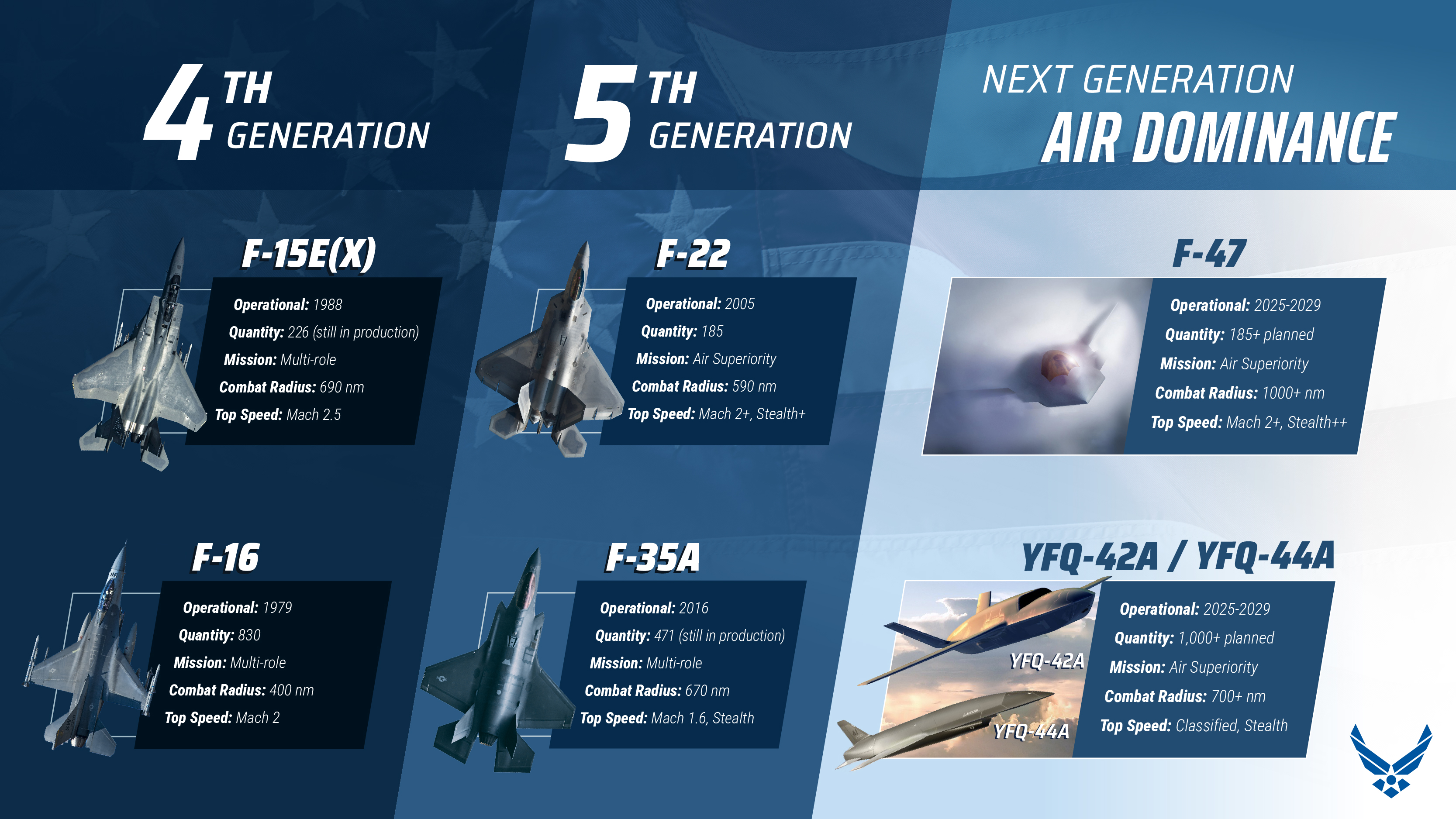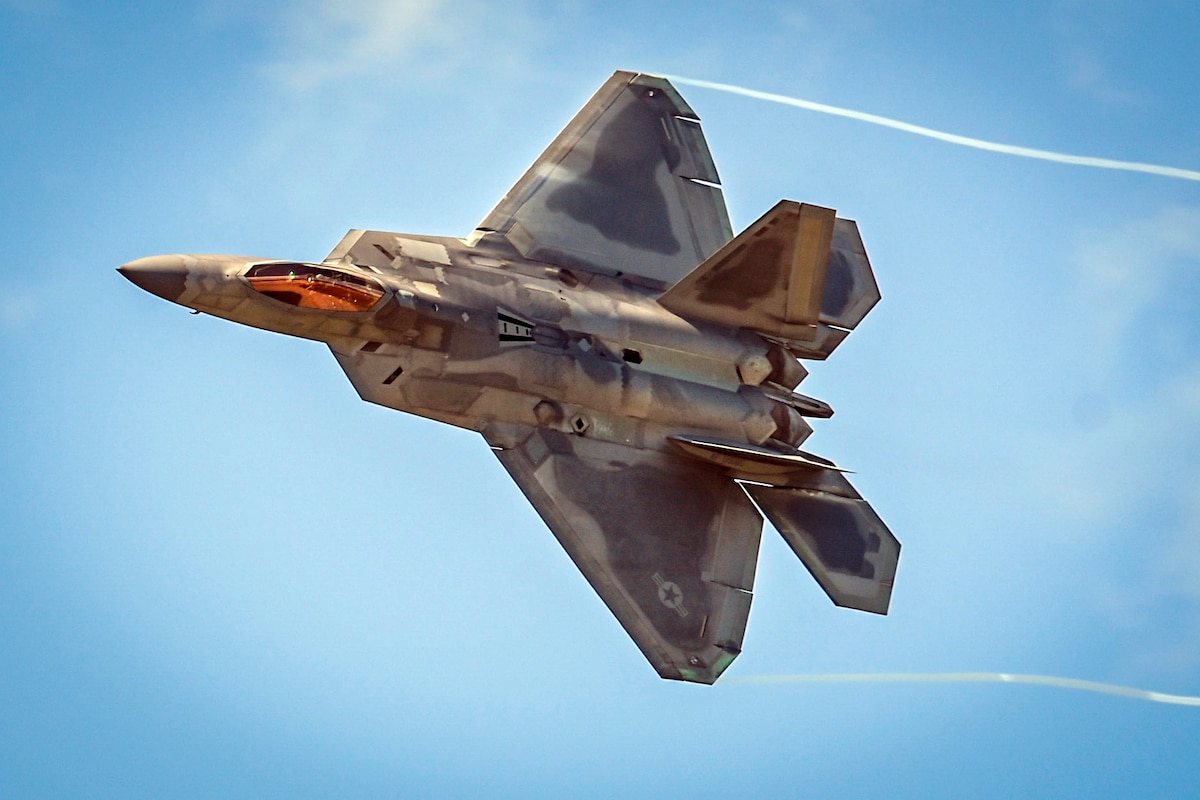The United States is slowly revealing some planned features and metrics of the F-47 sixth-generation fighter jet, such as the combat radius, nearly two months after US President Donald Trump awarded the contract to Boeing.
This next-generation F-47 will go much farther than the F-22 Raptor it is meant to replace.
The US Air Force (USAF) Chief of Staff, Gen. David Allvin, published an infographic on the social media site X that provides some details of the F-47 for the first time.
The infographic features the fourth-generation F-16 and F-15EX, the fifth-generation F-22 and the F-35, and the sixth-generation F-47, along with the caption, “Our US Air Force will continue to be the world’s best example of speed, agility, and lethality.”
It also features the YFQ-42A and YFQ-44A collaborative combat aircraft, which were classified as fighters in March 2025 and are expected to operate as loyal wingman aircraft with crewed fighter jets.
The most notable information on the F-47, the USAF’s sixth-generation aircraft, which remains cloaked in secrecy, is that it will have a combat radius of 1000 nautical miles or 1,800 kilometres.
Our @usairforce will continue to be the world’s best example of speed, agility, and lethality. Modernization means fielding a collection of assets that provide unique dilemmas for adversaries—matching capabilities to threats—while keeping us on the right side of the cost curve. pic.twitter.com/vqjxCdBYid
— General David Allvin (@OfficialCSAF) May 13, 2025
This is an incredible distance for the USAF’s next-generation aircraft, particularly because it will be able to fly a great distance without requiring refuelling. An aircraft’s combat radius is the distance it can fly before running out of fuel to return to its base without stopping.
It signifies a major upgrade over the fifth-generation fighters in the USAF’s inventory. As seen in the infographic, the F-22 Raptor has a combat range of 590 nautical miles or about 1,100 kilometres, whereas the F-35 Lightning II has a combat range of 670 nautical miles or over 1,200 kilometres. The F-47 will eventually replace the F-22 Raptor. Thus, it represents a major increase in combat radius.

Moreover, the F-47 is expected to operate with AI-powered drone wingmen (CCAs), which will further extend its effective range. Since the estimate of 1000+ is a rather vague (and indefinite) description, it would be premature to assess whether an aircraft with this combat radius would be able to deploy from forward US bases like Guam or Hawaii and penetrate the advanced Chinese anti-access/area denial (A2/AD) network as has been anticipated by aviation experts and enthusiasts.
Nonetheless, in case of a conflict between the US and China in the vast Indo-Pacific region, a longer combat radius will likely allow the F-47 to loiter longer in contested areas, providing persistent air superiority, intelligence, surveillance, reconnaissance (ISR), and crucial strike capabilities.
The F-47 will also have a top speed of more than Mach 2, which is the same as the F-22 Raptor and more than the Mach 1.6 speed of the F-35. Earlier, while awarding the contract, Donald Trump had said, “There’s never been anything even close to it, from speed to manoeuverability, to what it can have, to payload.”
As per the infographic, the F-47 will have ‘stealth++’—an advancement from the Raptor’s ‘stealth+’ and F-35’s ‘stealth.’ This aligns with the existing information on the F-47, which is envisioned to be a very low-observable aircraft. Multiple reports published in the EurAsian Times in the past have discussed the broad-spectrum stealth that the aircraft will likely have, as well as potential countermeasures to radars.

This is an indispensable need in the combat of the future, particularly against adversaries like China. In fact, China is currently flying two different prototypes of its sixth-generation fighter jets, named J-36 and J-50.
Not much is known about the J-36 fighters except that they feature broad-spectrum stealth and, like the F-47, are a system of systems, positioning China ahead in the global stealth race. Additionally, the tailless delta platforms of the new Chinese fighters (including the J-50) give them the highest possible multispectral radar stealth.
The infographic posted by General Allvin also states that more than 185 F-47s are currently planned for the USAF. This aligns with the number of F-22 Raptors in the US inventory, which the F-47 is expected to replace, probably into the late 2030s or early 2040s.
Notably, the infographic states that the F-47 will become operational between 2025 and 2029, which appears to be a rather optimistic timeline, considering the complexity associated with a sixth-generation platform and the maturation of technology.
Earlier, General Allvin had also said the F-47 would cost less than the F-22. It will be more adaptable to future threats and “have significantly longer range, more advanced stealth, be more sustainable, supportable, and have higher availability than our fifth-generation fighters.”
Besides the F-47, the CCAs listed are also extremely significant, as they are expected to play a crucial role in combat with a near-peer adversary like China. The YFQ-42A and YFQ-44A will have a combat radius of 700 nautical miles. They will operate alongside the F-35 and perhaps even the F-47, further increasing the actual combat radius of the fighter jets.
The YFQ-42A and YFQ-44A are Increment 1 designs in the CCA program. These CCAs, or loyal wingman drones, will function as force multipliers by providing additional firepower, sensor coverage, and electronic warfare capabilities while enhancing the survivability of the crewed fighter jets.
The USAF had earlier stated that it envisions a single crewed fighter like the F-47 controlling multiple CCAs. More than 1,000 CCAs will be produced.
While listing these aircraft as a key capability of the modern USAF, General Allvin stated: “Modernization means fielding a collection of assets that provide unique dilemmas for adversaries—matching capabilities to threats—while keeping us on the right side of the cost curve.”
F-47 Is Gathering Pace!
Though the infographic is the first-ever peek into the F-47, which is a classified program, it does not offer any definite information, much like the photos of the program released by the USAF in March.
The USAF and industry officials told Air & Space Forces Magazine last month that although the images showed only a small portion of the aircraft, they are merely placeholders and are not meant to depict the aircraft realistically.
The pictures depict a stealthy-looking aircraft from the nose and cockpit to the leading edges of the wings, which exhibit a noticeable upward angle, or dihedral. The photos also featured canard foreplanes, which seem fixed rather than articulated. Air intakes are not visible.
While several aviation experts have written in-depth analyses of the F-47 photos, especially of the canards, whose use would be hard to reconcile with the idea of the F-47 as an “extremely low observable” design, the Air Force official advised that the images be “taken with a large grain of salt.” “We aren’t giving anything away in those pictures,” he said. “You’ll have to be patient” to see what it really looks like, he said, adding, “Is there a resemblance? Maybe.”
There is currently a paucity of information on the specific features of what will be the most advanced aircraft of the USAF. As per predictions made by experts, the F-47 will likely have broad spectrum stealth, next-generation power plants, artificial intelligence and manned-unmanned teaming, optionally manned configurations, directed energy weapons, hypersonic weapon integration, unified electronic warfare system, inflight software upgrades, radio photonic radar, and multi-spectral optical systems operating in various ranges – the laser, infrared, ultraviolet, and in the optical band, among other things.

Some experts earlier stated that F-47 will feature adaptive cycle engines, which will allow pilots to switch between high-thrust and fuel-efficient modes dynamically, offering greater range and maneuverability.
Combined with advanced thrust vectoring and internal weapons bays, the F-47 could potentially maximize stealth and kinematic performance. Moreover, the fighter would operate as a flying node in a digital kill web.
The F-47 will join the Northrop Grumman B-21 Raider bomber to form the sixth-generation fighter fleet. Air Force Chief of Staff Gen. David Allvin said, “The aircraft will have sensor fusion, long-range strike capabilities, and next-generation stealth to counter the most sophisticated adversaries in contested environments.”
During his announcement of the NGAD program, President Trump stated that an experimental version of the sixth-generation fighter jet has been secretly flying for almost five years. Though no costs or timelines for NGAD production were released during the press conference, the president said a fleet of F-47s would be “built” during his current administration.
For now, this explains the 2025-2029 timeline in the infographic.
- Contact the author at sakshi.tiwari9555(at)gmail.com
- Follow EurAsian Times on Google News




